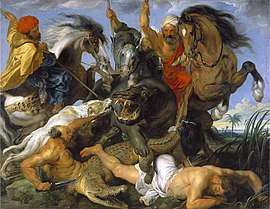Hippopotamus
The hippopotamus (/ˌhɪpəˈpɒtəməs/ HIP-ə-POT-ə-məs;[3] Hippopotamus amphibius), also called the hippo, common hippopotamus or river hippopotamus, is a large, mostly herbivorous, semiaquatic mammal and ungulate native to sub-Saharan Africa. It is one of only two extant species in the family Hippopotamidae, the other being the pygmy hippopotamus (Choeropsis liberiensis or Hexaprotodon liberiensis). The name comes from the ancient Greek for "river horse" (ἱπποπόταμος). After the elephant and rhinoceros, both of which are found in Africa, the hippopotamus is the third-largest type of land mammal and the heaviest extant artiodactyl. Despite their physical resemblance to pigs and other terrestrial even-toed ungulates, the closest living relatives of the Hippopotamidae are cetaceans (whales, dolphins, porpoises, etc.) from which they diverged about 55 million years ago.
| Hippopotamus | |
|---|---|
%2C_parque_nacional_de_Chobe%2C_Botsuana%2C_2018-07-28%2C_DD_82.jpg) | |
| A hippopotamus in Chobe National Park, Botswana | |
| Scientific classification | |
| Kingdom: | Animalia |
| Phylum: | Chordata |
| Class: | Mammalia |
| Order: | Artiodactyla |
| Family: | Hippopotamidae |
| Genus: | Hippopotamus |
| Species: | H. amphibius |
| Binomial name | |
| Hippopotamus amphibius | |
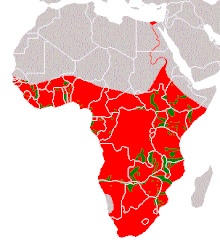 | |
| Range map of the hippopotamus. Historic range is in red while current range is in green.[1] | |
Hippos are recognisable by their barrel-shaped torsos, wide-opening mouths revealing large canine tusks, nearly hairless bodies, columnar legs and large size; adults average 1,500 kg (3,310 lb) for males and 1,300 kg (2,870 lb) for females. Despite its stocky shape and short legs, it is capable of running 30 km/h (19 mph) over short distances.
Hippos inhabit rivers, lakes, and mangrove swamps, where territorial males preside over a stretch of river and groups of five to thirty females and young hippos. During the day, they remain cool by staying in the water or mud; reproduction and childbirth both occur in water. They emerge at dusk to graze on grasses. While hippos rest near each other in the water, grazing is a solitary activity and hippos are not territorial on land. The hippo is among the most dangerous animals in the world due to its highly aggressive and unpredictable nature. They are threatened by habitat loss and poaching for their meat and ivory canine teeth.
Etymology
The Latin word "hippopotamus" is derived from the ancient Greek ἱπποπόταμος, hippopótamos, from ἵππος, híppos, "horse", and ποταμός, potamós, "river", meaning "horse of the river".[4][5][6] In English, the plural is "hippopotamuses", but "hippopotami" is also used;[7] "hippos" can be used as a short plural. Hippos are gregarious, living in groups of up to thirty animals. A group is called a pod, herd, dale, or bloat.
Taxonomy and origins
Classification
Hippopotamus is the type genus of the family Hippopotamidae. The pygmy hippopotamus belongs to a different genus in Hippopotamidae, either Choeropsis or Hexaprotodon. Hippopotamidae are sometimes known as hippopotamids. Sometimes, the subfamily Hippopotaminae is used. Further, some taxonomists group hippos and anthracotheres in the superfamily Anthracotheroidea.[8]:39 Hippopotamidae are classified along with other even-toed ungulates in the order Artiodactyla. Other artiodactyls include camels, cattle, deer and pigs, although hippos are not closely related to these groups.
%2C_parque_nacional_de_Chobe%2C_Botsuana%2C_2018-07-28%2C_DD_60.jpg)
Five subspecies of hippos have been described based on morphological differences in their skulls and geographical differences:[8]:3
- Great northern hippopotamus or Nile hippopotamus H. a. amphibius – (the nominate subspecies) which stretched from Egypt, where they are now extinct, south up the Nile River to Tanzania and Mozambique
- East African hippopotamus H. a. kiboko – in Kenya in the African Great Lakes region, and in Somalia in the Horn of Africa. Broader nasals and more hollowed interorbital region
- Cape hippopotamus or South African hippopotamus H. a. capensis – from Zambia to South Africa, most flattened skull of the subspecies
- West African hippopotamus or Tchad hippopotamus H. a. tschadensis – throughout Western Africa to, as the name suggests, Chad, slightly shorter and wider face, with prominent orbits
- Angola hippopotamus H. a. constrictus – in Angola, the southern Democratic Republic of Congo and Namibia, named for its deeper preorbital constriction
The suggested subspecies were never widely used or validated by field biologists; the described morphological differences were small enough that they could have resulted from simple variation in nonrepresentative samples.[8]:2 Genetic analyses have tested the existence of three of these putative subspecies. A study examining mitochondrial DNA from skin biopsies taken from 13 sampling locations, considered genetic diversity and structure among hippo populations across the continent. The authors found low, but significant, genetic differentiation among H. a. amphibius, H. a. capensis, and H. a. kiboko. Neither H. a. tschadensis nor H. a. constrictus has been tested.[9][10]
Evolution
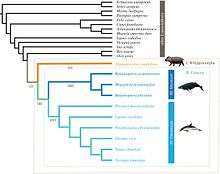
Until 1909, naturalists grouped hippos with pigs, based on molar patterns. Several lines of evidence, first from blood proteins, then from molecular systematics[12] and DNA [13][14] and the fossil record, show that their closest living relatives are cetaceans – whales, dolphins and porpoises.[15] The common ancestor of hippos and whales branched off from Ruminantia and the rest of the even-toed ungulates; the cetacean and hippo lineages split soon afterwards.[13][16]
| Artiodactyla |
| ||||||||||||||||||||||||
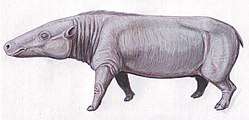
The most recent theory of the origins of Hippopotamidae suggests that hippos and whales shared a common semiaquatic ancestor that branched off from other artiodactyls around 60 million years ago.[13][15] This hypothesised ancestral group likely split into two branches around 54 million years ago.[12]
One branch would evolve into cetaceans, possibly beginning about 52 million years ago, with the protowhale Pakicetus and other early whale ancestors collectively known as Archaeoceti, which eventually underwent aquatic adaptation into the completely aquatic cetaceans.[16] The other branch became the anthracotheres, a large family of four-legged beasts, the earliest of which in the late Eocene would have resembled skinny hippos with comparatively small and narrow heads. All branches of the anthracotheres, except that which evolved into Hippopotamidae, became extinct during the Pliocene without leaving any descendants.[15]
A rough evolutionary lineage can be traced from Eocene and Oligocene species: Anthracotherium and Elomeryx to the Miocene species Merycopotamus and Libycosaurus and the very latest anthracotheres in the Pliocene.[17] Merycopotamus, Libycosaurus and Hippopotamidae can be considered to form a clade, with Libycosaurus being more closely related to hippos. Their common ancestor would have lived in the Miocene, about 20 million years ago. Hippopotamidae are therefore deeply nested within the family Anthracotheriidae.
Hippopotamidae are believed to have evolved in Africa; the oldest known hippopotamid is the genus Kenyapotamus, which lived in Africa from 16 to 8 million years ago. While hippopotamid species spread across Asia and Europe, no hippos have ever been discovered in the Americas, although various anthracothere genera emigrated into North America during the early Oligocene. From 7.5 to 1.8 million years ago, an ancestor to the modern hippo, Archaeopotamus, lived in Africa and the Middle East.[18]
While the fossil record of hippos is still poorly understood, the two modern genera, Hippopotamus and Choeropsis (sometimes Hexaprotodon), may have diverged as far back as 8 million years ago. Taxonomists disagree whether or not the modern pygmy hippopotamus is a member of Hexaprotodon – an apparently paraphyletic genus, also embracing many extinct Asian hippopotamuses, that is more closely related to Hippopotamus – or of Choeropsis, an older and basal genus.[17][18]
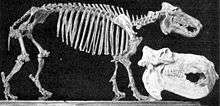
Extinct species
Three species of Malagasy hippopotamus became extinct during the Holocene on Madagascar, one of them within the past 1,000 years. The Malagasy hippos were smaller than the modern hippo, likely through the process of insular dwarfism.[19] Fossil evidence indicates many Malagasy hippos were hunted by humans, a likely factor in their eventual extinction.[19] Isolated members of Malagasy hippos may have survived in remote pockets; in 1976, villagers described a living animal called the kilopilopitsofy, which may have been a Malagasy hippo.[20]
Three species of hippopotamus, the European hippopotamus (Hippopotamus antiquus), Hippopotamus major and Hippopotamus gorgops, ranged throughout continental Europe and the British Isles. All three species became extinct before the last glaciation. Ancestors of European hippos found their way to many islands of the Mediterranean Sea during the Pleistocene.[21] The Pleistocene also saw a number of dwarf species evolve on several Mediterranean islands, including Crete (Hippopotamus creutzburgi), Cyprus (the Cyprus dwarf hippopotamus, Hippopotamus minor), Malta (Hippopotamus melitensis), and Sicily (Hippopotamus pentlandi). Of these, the Cyprus dwarf hippo survived until the end of the Pleistocene or early Holocene. Evidence from an archaeological site, Aetokremnos, continues to cause debate on whether or not the species was encountered, and was driven to extinction, by man.[22][21]
Physical attributes
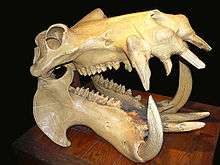
Hippos are among the largest living land mammals, being only smaller than elephants and some rhinoceroses. Among the extant African megafauna, behind the two African elephant species, they average smaller than the white rhinoceros but are larger by body mass than the black rhinoceros and the giraffe. Mean adult weight is around 1,500 kg (3,310 lb) and 1,300 kg (2,870 lb) for males and females respectively,[23][24] very large males can reach 2,000 kg (4,410 lb) and exceptional males weighing 2,660 kg (5,860 lb)[23], 3,200 kg (7,050 lb)[25] and 4,500 kg (9,920 lb) (in captivity)[26] have been reported. Male hippos appear to continue growing throughout their lives while females reach maximum weight at around age 25.[27]
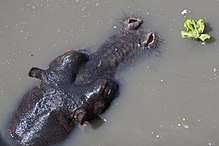
Hippos have barrel-shaped bodies with short legs and long muzzles.[28] Their skeletal structures are graviportal,[8]:8 adapted to carrying their enormous weight, and their specific gravity allows them to sink and move along the bottom of a river.[29] Hippopotamuses have small legs (relative to other megafauna) because the water in which they live reduces the weight burden.[30] Though they are bulky animals, hippos can gallop at 30 km/h (19 mph) on land but normally trot. They are incapable of jumping but do climb up steep banks.[28] Despite being semiaquatic and having webbed feet, an adult hippo is not a particularly good swimmer nor can it float. It is rarely found in deep water; when it is, the animal moves by porpoise-like leaps from the bottom.[8]:3 The eyes, ears, and nostrils of hippos are placed high on the roof of their skulls. This allows these organs to remain above the surface while the rest of the body submerges.[31]:259 The testes of the males descend only partially and a scrotum is not present. In addition, the penis retracts into the body when not erect. The genitals of the female hippos are unusual in that the vagina is ridged and two large diverticula protrude from the vulval vestibule. The function of these is unknown.[8]:28–29
%2C_parque_nacional_de_Chobe%2C_Botsuana%2C_2018-07-28%2C_DD_79.jpg)
The hippo's jaw is powered by a large masseter and a well-developed digastric; the latter loops up behind the former to the hyoid.[31]:259 The jaw hinge is located far back enough to allow the animal to open its mouth at almost 180°.[8]:17 A moderate folding of the orbicularis oris muscle allows the hippo to achieve such a gape without tearing any tissue.[32] The bite force of an adult female hippo has been measured as 8,100 newtons (1,800 lbf).[33] Hippo teeth sharpen themselves as they grind together. The lower canines and lower incisors are enlarged, especially in males, and grow continuously. The incisors can reach 40 cm (1 ft 4 in), while the canines reach up to 50 cm (1 ft 8 in).[28] The canines and incisors are used for combat and play no role in feeding. Hippos rely on their broad horny lips to grasp and pull grasses which are then ground by the molars.[31]:259, 263 The hippo is considered to be a pseudoruminant; it has a complex three-chambered stomach but does not "chew cud".[8]:22
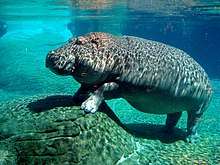
Unlike most other semiaquatic animals, hippos have very little hair.[31]:260 The skin is 6 cm (2 in) thick,[28] providing it great protection against conspecifics and predators. By contrast, its subcutaneous fat layer is thin.[8]:3 The animals' upper parts are purplish-grey to blue-black, while the under parts and areas around the eyes and ears can be brownish-pink.[31]:260 Their skin secretes a natural sunscreen substance which is red-coloured. The secretion is sometimes referred to as "blood sweat", but is neither blood nor sweat. This secretion is initially colourless and turns red-orange within minutes, eventually becoming brown. Two distinct pigments have been identified in the secretions, one red (hipposudoric acid) and one orange (norhipposudoric acid). The two pigments are highly acidic compounds. They inhibit the growth of disease-causing bacteria, and their light absorption peaks in the ultraviolet range, creating a sunscreen effect.[34][35] All hippos, even those with different diets, secrete the pigments, so it does not appear that food is the source of the pigments. Instead, the animals may synthesise the pigments from precursors such as the amino acid tyrosine.[35] Nevertheless, this natural sunscreen cannot prevent the animal's skin from cracking if it stays out of water too long.[36] The secretion does help regulate the body temperature of the hippo and acts an antibiotic source.[37]
A hippo's lifespan is typically 40–50 years.[31]:277 Donna the Hippo was the oldest living hippo in captivity. She lived at the Mesker Park Zoo in Evansville, Indiana in the US[38][39] until her death in 2012 at the age of 61.[40]
Distribution and status
Hippopotamus amphibius was widespread in North Africa and Europe during the Eemian[41] and late Pleistocene until about 30,000 years ago. Archaeological evidence exists of its presence in the Levant, dating to less than 3,000 years ago.[42][43] The species was common in Egypt's Nile region during antiquity, but has since been extirpated. Pliny the Elder writes that, in his time, the best location in Egypt for capturing this animal was in the Saite nome;[44] the animal could still be found along the Damietta branch after the Arab Conquest in 639. Reports of the slaughter of the last hippo in Natal Province were made at the end of the 19th century.[45] Hippos are still found in the rivers and lakes of the northern Democratic Republic of the Congo, Uganda, Tanzania and Kenya, north through to Ethiopia, Somalia and Sudan, west to The Gambia, and south to South Africa.
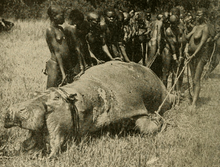
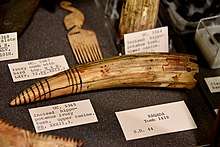
Genetic evidence suggests that common hippos in Africa experienced a marked population expansion during or after the Pleistocene, attributed to an increase in water bodies at the end of the era. These findings have important conservation implications as hippo populations across the continent are currently threatened by loss of access to fresh water.[9] Hippos are also subject to unregulated hunting and poaching. In May 2006, the hippo was identified as a vulnerable species on the IUCN Red List drawn up by the International Union for Conservation of Nature (IUCN), with an estimated population of between 125,000 and 150,000 hippos, a decline of between 7% and 20% since the IUCN's 1996 study. Zambia (40,000) and Tanzania (20,000–30,000) possess the largest populations.[1]
The hippo population declined most dramatically in the Democratic Republic of the Congo.[46] By 2005, the population in Virunga National Park had dropped to 800 or 900 from around 29,000 in the mid-1970s.[47] The decline is attributed to the disruptions caused by the Second Congo War.[47] The poachers are believed to be Mai-Mai rebels, poorly paid Congolese soldiers, and local militia groups.[47][48] Reasons for poaching include the belief that hippos are harmful to society, as well as financial gain.[49] However, as of 2016, the Virunga hippo population appears to have increased, possibly due to greater enforcement and cooperation between fishermen and park authorities.[50] The sale of hippo meat is illegal, but black-market sales are difficult for Virunga National Park officers to track.[48][49] Hippo meat is considered a delicacy in some areas of central Africa and the teeth have become a valued substitute for elephant ivory.[51]
Introduction to Colombia
In the late 1980s, Colombian drug lord Pablo Escobar kept four hippos in a private menagerie at his residence in Hacienda Nápoles, 100 kilometres (62 mi) east of Medellín, Colombia. They were deemed too difficult to seize and move after Escobar's death, and hence left on the untended estate. By 2007, the animals had multiplied to 16 and had taken to roaming the area for food in the nearby Magdalena River.[52][53] In 2013, the National Geographic Channel produced a documentary about them titled Cocaine Hippos.[54] As of early 2014, 40 hippos were reported to exist in Puerto Triunfo, Antioquia from the original four belonging to Escobar,[55] and in 2018 the growing population was estimated at 50–70.[56] In December 2019, it was estimated that there were 65–80 individuals with their range covering almost 2,000 km2 (770 sq mi) in Antioquia, Bolívar, Boyacá, Cundinamarca and Santander; it is expected that the population will increase to 150 individuals within a decade and that the range eventually could cover more than 13,500 km2 (5,200 sq mi).[57] Population projections estimate that there could be thousands within a few decades.[58]
Being non-native introductions, most conservationists considered them problematic and invasive in Colombia, as they have the potential to change the ecosystems, feeding heavily on plants and displacing native species like the West Indian manatee, Neotropical otter, spectacled caiman and turtles.[57][59][60] The critically endangered Dahl's toad-headed turtle and Magdalena River turtle are largely restricted to the Magdalena River basin,[61] as are many threatened fish.[62] In 2020, a study showed that there was an increase in the nutrient levels and cyanobacteria in Colombian lakes inhabited by hippos. Cyanobacteria can cause toxic algae blooms and die-offs of aquatic fauna. Despite the limited magnitude of the observed change, it was noticeable since the species' population was still quite small.[59][60] Additionally, they can represent a serious threat to fishers and other locals. There have been attacks on humans, but as of 2017 nobody had been killed or seriously injured by the Colombian hippos.[63]
In contrast to the opposition by most conservationists, some ecologists have argued that they should remain and might even have a positive effect on the local environment. It has been suggested that the nutrients they introduce to the water and the occasional fish kills caused by them are overall positive,[59] but this was based on a study in their native Africa.[64] Alternatively, the introduced hippos could be a form of Pleistocene rewilding project, replacing species like Toxodon that became extinct in prehistoric times,[59] but Pleistocene rewilding itself is highly controversial.[65] Others have argued that the Colombian hippos should be regarded as a safe population, isolated from the threats faced by African hippos, and that they could be benefitial to the local ecotourism industry.[59]
In 2009, two adults and one calf left their herd and, after attacking humans and killing cattle, one of the adults (called "Pepe") was killed by hunters under authorisation of the local authorities.[53] When a photo of the dead hippo became public, it caused considerable controversy among animal rights groups both within the country and abroad, and further plans of culling ceased. Alternative methods have been considered, but they are unproven, or difficult and expensive. A wild male hippo was caught, castrated and released again, but it cost about US$50,000.[63] As of 2020, there were no plans by the local government on managing the population, but further studies on their effect on the habitat have been initiated.[59] Because of the fast-growing population, conservationists have recommended that a management plan needs to be rapidly developed.[57][58]
Proposed introduction to the United States
In the U.S., Representative Robert F. Broussard of Louisiana introduced the "American Hippo bill" in 1910 to authorise the importation and release of hippopotamus into the bayous of Louisiana.[66][67] Broussard argued that the hippos would eat the invasive water hyacinth that was clogging the rivers and also produce meat to help solve the American meat crisis.[67][68] The chief collaborators and proponents of Broussard's bill were Major Frederick Russell Burnham and Captain Fritz Duquesne.[69][70] Former President Theodore Roosevelt backed the plan, as did the U.S. Department of Agriculture, The Washington Post, and The New York Times which praised the taste of hippo as "like cow bacon".[69] The "American Hippo Bill" fell just short of being passed.[67]
Behaviour and life history
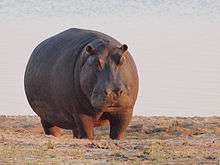
Hippos differ from all other large land mammals, being of semiaquatic habits, and spending their days in lakes and rivers.[8]:3 They can be found in both savannah and forest areas.[1] Proper habitat requires enough water to submerge in and grass nearby.[28] Larger densities of the animals inhabit quiet waters with mostly firm, smooth sloping beaches. Male hippos may be found in very small numbers in rapid waters in rocky gorges.[31]:264 Hippos mostly live in freshwater habitats, however populations in West Africa mostly inhabit estuarine waters and may even be found at sea.[1] With the exception of eating, most of a hippo's life occurs in the water. Hippos leave the water at dusk and travel inland, sometimes up to 15 km (9 mi),[28] to graze on short grasses, their main source of food. They spend four to five hours grazing and can consume 68 kg (150 lb) of grass each night.[71]
_grazing_(12033127823).jpg)
Like most herbivores, hippos consume other plants if presented with them, but their diet in nature consists almost entirely of grass, with only minimal consumption of aquatic plants.[72] Hippos are born with sterile intestines, and require bacteria obtained from their mothers' feces to digest vegetation.[73] On occasion, hippos have been filmed eating carrion, usually near the water. There are other reports of meat-eating, and even cannibalism and predation.[74] The stomach anatomy of a hippo is not suited to carnivory, and meat-eating is likely caused by aberrant behaviour or nutritional stress.[8]:84
Hippo defecation creates allochthonous deposits of organic matter along the river beds. These deposits have an unclear ecological function.[72] A 2015 study concluded that hippo dung provides nutrients from terrestrial material for fish and aquatic invertebrates,[75] while a 2018 study found that their dung can be toxic to aquatic life in large quantities, due to absorption of dissolved oxygen in water bodies.[76][77] Because of their size and their habit of taking the same paths to feed, hippos can have a significant impact on the land across which they walk, both by keeping the land clear of vegetation and depressing the ground. Over prolonged periods, hippos can divert the paths of swamps and channels.[78] Adult hippos move at speeds up to 8 km/h (5 mph) in water; typically resurfacing to breathe every three to five minutes. The young have to breathe every two to three minutes.[8]:4 The process of surfacing and breathing is subconscious: a hippo sleeping underwater will rise and breathe without waking up. A hippo closes its nostrils when it submerges into the water.[79] As with fish and turtles on a coral reef, hippos occasionally visit cleaning stations and signal, by opening their mouths wide, their readiness for being cleaned of parasites by certain species of fishes. This is an example of mutualism, in which the hippo benefits from the cleaning while the fish receive food.[80] The hippos spend up to 16 hours a day in water as a way to stay cool.[37]
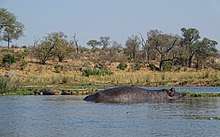
Hippos coexist with a variety of large predators. Nile crocodiles, lions and spotted hyenas are known to prey on young hippos.[31]:273[8]:118 However, due to their aggression and size, adult hippos are not usually preyed upon by other animals. Cases where large lion prides have successfully preyed on adult hippos have been reported; however, this predation is generally rare.[81] Lions occasionally prey on adults at Gorongosa National Park and calves are sometimes taken at Virunga.[82] Crocodiles are frequent targets of hippo aggression, probably because they often inhabit the same riparian habitats; crocodiles may be either aggressively displaced or killed by hippos.[83] In turn, beyond cases of killing the seldom unguarded hippo calf, very large Nile crocodiles have been verified to occasionally prey on "half-grown" hippos and anecdotally perhaps adult female hippos. Aggregations of crocodiles have also been seen to dispatch still-living male hippos that have been previously injured in mating battles with other males.[84][85][86]
Social spacing
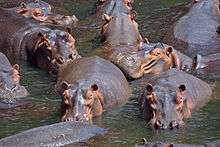
Studying the interaction of males and females has long been complicated because hippos are not sexually dimorphic; thus females and young males are almost indistinguishable in the field.[87] Although hippos lie close to each other, they do not seem to form social bonds except between mothers and daughters, and they are not social animals. The reason they huddle close together is unknown.[8]:49 Hippos are territorial only in water, where a male presides over a small stretch of river, on average 250 m (270 yd) in length, and containing 10 females. The largest pods can contain over 100 hippos.[8]:50 Younger bachelors are allowed in a male's stretch, as long as they behave submissively toward the male. The territories of hippos exist to establish mating rights. Within the pods, the hippos tend to segregate by gender. Bachelors lounge near other bachelors, females with other females, and the male on his own. When hippos emerge from the water to graze, they do so individually.[8]:4
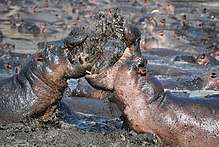
Hippos mark their territory by defecation. While depositing the faeces, hippos spin their tails to distribute their excrement over a greater area.[88] "Yawning" serves as a threat display.[28] When fighting, males use their incisors to block each other's attacks and their large canines to inflict injuries.[31]:260 When hippos become over-populated or a habitat is reduced, males sometimes attempt infanticide, but this behaviour is not common under normal conditions.[89] Incidents of hippo cannibalism have been documented, but this is believed to be the behaviour of distressed or sick hippos.[8]:82–83
Hippos appear to communicate vocally, through grunts and bellows, and they may practice echolocation, but the purpose of these vocalisations is currently unknown. Hippos have the unique ability to hold their heads partially above the water and send out a cry that travels through both water and air; individuals respond above and under water.[90] Hippos will also express threat and alarm with exhalations.[28]
Reproduction
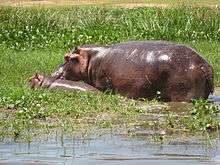
Female hippos reach sexual maturity at five to six years and have a gestation period of eight months.[91] A study of endocrine systems revealed that female hippos may begin puberty as early as three or four years.[92] Males reach maturity at around 7.5 years. A study of hippo reproductive behaviour in Uganda showed that peak conceptions occurred during the end of the wet season in the summer, and peak births occurred toward the beginning of the wet season in late winter. This is because of the female's oestrous cycle; as with most large mammals, male hippo spermatozoa is active year-round. Studies of hippos in Zambia and South Africa also showed evidence of births occurring at the start of the wet season.[8]:60–61 After becoming pregnant, a female hippo will typically not begin ovulation again for 17 months.[92]
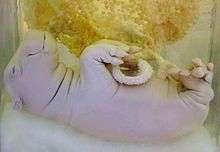
Mating occurs in the water, with the female submerged for most of the encounter,[8]:63 her head emerging periodically to draw breath. Female hippos isolate themselves to give birth and return within 10–14 days.[28] Calves are born underwater at a weight between 25 and 50 kg (55 and 110 lb) and an average length of around 127 cm (4.17 ft), and must swim to the surface to take their first breaths. A mother typically gives birth to only one calf, although twins also occur. The young often rest on their mothers' backs when the water is too deep for them, and they swim under water to suckle. They suckle on land when the mother leaves the water.[8]:64
Mother hippos are very protective of their young and may keep others at a distance. However, calves are occasionally left in nurseries which are guarded by one or a few adults. Calves in nurseries engage in playfights.[28] Weaning starts between six and eight months after birth, and most calves are fully weaned after a year.[8]:64 Like many other large mammals, hippos are described as K-strategists, in this case typically producing just one large, well-developed infant every couple of years (rather than many small, poorly developed young several times per year as is common among small mammals such as rodents).[92][89]
Hippos and humans
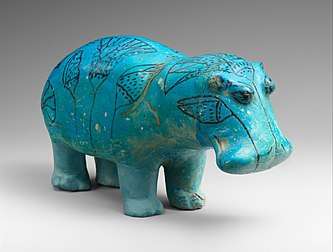
The earliest evidence of human interaction with hippos comes from butchery cut marks on hippo bones at Bouri Formation dated around 160,000 years ago.[93] Later rock paintings and engravings showing hippos being hunted have been found in the mountains of the central Sahara dated 4,000–5,000 years ago near Djanet in the Tassili n'Ajjer Mountains.[8]:1 The ancient Egyptians recognised the hippo as a ferocious denizen of the Nile and representations on the tombs of nobles show that the animals were hunted.[94]
The hippo was also known to the Greeks and Romans. The Greek historian Herodotus described the hippo in The Histories (written circa 440 BC) and the Roman naturalist Pliny the Elder wrote about the hippo in his encyclopedia Naturalis Historia (written circa 77 AD).[44][95] The Yoruba people called the hippo erinmi, which means "elephant of the water".[96] Zulu warriors preferred to be as brave as a hippo, since even lions were not considered to match its courage.[97] They would chant their chief: "Een-gonyama Gonyama! Invooboo! Yah-bo! Yah-bo! Invooboo!" which translates as "He is a lion. Yes, he is better than a lion – he is a hippopotamus."[98]
Attacks on humans
The hippo is considered to be extremely aggressive and has frequently been reported charging and attacking boats.[99] Small boats can easily be capsized by hippos and passengers can be injured or killed by the animals or drown. In one 2014 case in Niger, a boat was capsized by a hippo and 13 people were killed.[100] As hippos will often engage in raiding nearby crops if the opportunity arises, humans may also come in conflict with them on these occasions, with potential for fatalities on both sides.[101]
In zoos
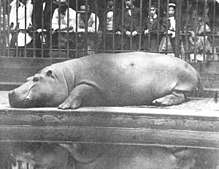
Hippos have long been popular zoo animals. The first zoo hippo in modern history was Obaysch, who arrived at the London Zoo on 25 May 1850, where he attracted up to 10,000 visitors a day and inspired a popular song, the "Hippopotamus Polka".[102] Hippos generally breed well in captivity; birth rates are lower than in the wild, but this is attributed to zoos wanting to limit births, since hippos are relatively expensive to maintain.[8]:129[102][103]
Like many zoo animals, hippos were traditionally displayed in concrete exhibits. In the case of hippos, they usually had a pool of water and patch of grass. In the 1980s, zoo exhibits increasingly reflected native habitats. For example, the Toledo Zoo Hippoquarium features a 360,000-US-gallon (1,400,000 l) pool.[104] In 1987, the Toledo Zoo saw the first underwater birth by a captive hippo.[105] The exhibit was so popular, the hippos became the logo of the Toledo Zoo.[106]
Cultural depictions
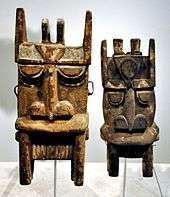
A red hippo represented the Ancient Egyptian god Set; the thigh is the "phallic leg of Set", symbolising virility. Set's consort Tawaret was also seen as part hippo[107] and was a goddess of protection in pregnancy and childbirth, because ancient Egyptians recognised the protective nature of a female hippo toward her young.[108] The Ijaw people of the Niger Delta wore masks of aquatic animals like the hippo when practicing their water spirit cults[109] and hippo ivory was used in the divination rituals of the Yoruba.[110] The Behemoth from the Book of Job, 40:15–24 is thought to be based on a hippo.[111]
Hippos have been the subjects of various African folktales. According to a San story; when the Creator assigned each animal its place in nature, the hippos wanted to live in the water, but were refused out of fear that they might eat all the fish. After begging and pleading, the hippos were finally allowed to live in the water on the conditions that they would eat grass instead of fish and would fling their dung so that it can be inspected for fish bones. In a Ndebele tale, the hippo originally had long, beautiful hair, but was set on fire by a jealous hare and had to jump into a nearby pool. The hippo lost most of his hair and was too embarrassed to leave the water.[112]

Ever since Obaysch inspired the "Hippopotamus Polka", hippos have been popular animals in Western culture for their rotund appearance that many consider comical.[102] Stories of hippos such as Huberta, which became a celebrity in South Africa in the 1930s for trekking across the country;[113] or the tale of Owen and Mzee, a hippo and tortoise which developed an intimate bond; have amused people who have bought hippo books, merchandise, and many stuffed hippo toys.[114][115] Hippos were mentioned in the novelty Christmas song "I Want a Hippopotamus for Christmas" that became a hit for child star Gayla Peevey in 1953. They also feature in the songs "The Hippopotamus" and "Hippo Encore" by Flanders and Swann, with the famous refrain "Mud, Mud, Glorious Mud". They even inspired a popular board game, Hungry Hungry Hippos.[116][117]
Hippos have also been popular cartoon characters, where their rotund frames are used for humorous effect. For example, the Disney film Fantasia featured a ballerina hippo dancing to the opera La Gioconda,[46] and Hanna-Barbera created Peter Potamus.[118]
The "Happy Hippos" characters were created in 1987 by the French designer André Roche to be hidden in the "Kinder Surprise egg" of the Italian chocolate company Ferrero SpA.[119]
References
- Lewison, R.; Pluháček, J. (2017). "Hippopotamus amphibius". IUCN Red List of Threatened Species. 2017: e.T10103A18567364. doi:10.2305/IUCN.UK.2017-2.RLTS.T10103A18567364.en. Retrieved 2 June 2018.
- "ITIS on Hippopotamus amphibius". Integrated Taxonomic Information System. Archived from the original on 26 August 2014. Retrieved 29 July 2007.
- "hippopotamus". Dictionary.com Unabridged. Random House. Retrieved 9 August 2019.
- ἱπποπόταμος, ἵππος, ποταμός. Liddell, Henry George; Scott, Robert; A Greek–English Lexicon at the Perseus Project.
- "Hippopotamus". Merriam-Webster's Online Dictionary. Retrieved 18 July 2007.
- Harper, Douglas. "hippopotamus". Online Etymology Dictionary.
- "Plural of hippopotamus". Oxford English Dictionary. Retrieved 18 July 2007.
- Eltringham, S.K. (1999). The Hippos. Poyser Natural History Series. Academic Press. ISBN 978-0-85661-131-5.
- Okello, J.B.A; Nyakaana, S.; Masembe, C.; Siegismund, H.R. an Arctander, P. (2005). "Mitochondrial DNA variation of the common hippopotamus: evidence for a recent population expansion". Heredity. 95 (3): 206–215. doi:10.1038/sj.hdy.6800711. PMID 16030528.CS1 maint: multiple names: authors list (link)
- Meijaard, Erik, ed. (September 2005). "Suiform Soundings: The IUCN/SSC Pigs, Peccaries, and Hippos Specialist Group (PPHSG) Newsletter" (PDF). IUCN. 5 (1).
- Tsagkogeorga, Georgia; McGowen, Michael R.; Davies, Kalina T. J.; Jarman, Simon; Polanowski, Andrea; Bertelsen, Mads F.; Rossiter, Stephen J. (2015). "A phylogenomic analysis of the role and timing of molecular adaptation in the aquatic transition of cetartiodactyl mammals". Royal Society Open Science. 2 (9): 150156. Bibcode:2015RSOS....250156T. doi:10.1098/rsos.150156. ISSN 2054-5703. PMC 4593674. PMID 26473040.
- Ursing, B.M.; Arnason U. (1998). "Analyses of mitochondrial genomes strongly support a hippopotamus-whale clade". Proceedings of the Royal Society. 265 (1412): 2251–5. doi:10.1098/rspb.1998.0567. PMC 1689531. PMID 9881471.
- Gatesy, J. (1 May 1997). "More DNA support for a Cetacea/Hippopotamidae clade: the blood-clotting protein gene gamma-fibrinogen" (PDF). Molecular Biology and Evolution. 14 (5): 537–543. doi:10.1093/oxfordjournals.molbev.a025790. PMID 9159931.
- Geisler, J. H.; Theodor, J. M. (2009). "Hippopotamus and whale phylogeny". Nature. 458 (7236): E1–4, discussion E5. Bibcode:2009Natur.458....1G. doi:10.1038/nature07776. PMID 19295550.
- Sanders, Robert (25 January 2005). "Scientists find missing link between the dolphin, whale and its closest relative, the hippo". Science News Daily. Archived from the original on 26 February 2015. Retrieved 8 January 2011.
- Boisserie, Jean-Renaud; Lihoreau, Fabrice; Brunet, Michel (2005). "The position of Hippopotamidae within Cetartiodactyla". Proceedings of the National Academy of Sciences. 102 (5): 1537–1541. Bibcode:2005PNAS..102.1537B. doi:10.1073/pnas.0409518102. PMC 547867. PMID 15677331.
- Boisserie, Jean-Renaud; Lihoreau, Fabrice; Brunet, Michel (2005). "Origins of Hippopotamidae (Mammalia, Cetartiodactyla): towards resolution". Zoologica Scripta. 34 (2): 119–143. doi:10.1111/j.1463-6409.2005.00183.x.
- Boisserie, Jean-Renaud (2005). "The phylogeny and taxonomy of Hippopotamidae (Mammalia: Artiodactyla): a review based on morphology and cladistic analysis" (PDF). Zoological Journal of the Linnean Society. 143: 1–26. doi:10.1111/j.1096-3642.2004.00138.x.
- Stuenes, Solweig (1989). "Taxonomy, habits and relationships of the sub-fossil Madagascan hippopotamuses Hippopotamus lemerlei and H. madagascariensis". Journal of Vertebrate Paleontology. 9 (3): 241–268. doi:10.1080/02724634.1989.10011761.
- Burney, David A.; Ramilisonina (1998). "The Kilopilopitsofy, Kidoky, and Bokyboky: Accounts of Strange Animals from Belo-sur-mer, Madagascar, and the Megafaunal "Extinction Window"". American Anthropologist. 100 (4): 957–966. doi:10.1525/aa.1998.100.4.957. JSTOR 681820.
- Petronio, C. (1995). "Note on the taxonomy of Pleistocene hippopotamuses" (PDF). Ibex. 3: 53–55. Archived from the original (PDF) on 12 September 2008.
- Simmons, A. (2000). "Faunal extinction in an island society: pygmy hippopotamus hunters of Cyprus". Geoarchaeology. 15 (4): 379–381. doi:10.1002/(SICI)1520-6548(200004)15:4<379::AID-GEA7>3.0.CO;2-E.
- Owen-Smith, R. Norman (1992). Megaherbivores: The Influence of Very Large Body Size on Ecology. Cambridge University Press.
- Pienaar, U. de V.; Van Wyk, P.; Fairall, N. (1966). "An experimental cropping scheme of Hippopotami in the Letaba river of the Kruger National Park". Koedoe. 9 (1). doi:10.4102/koedoe.v9i1.778.
- Stewart Keith Eltringham (1999). The Hippos: Natural History and Conservation. T & A D Poyser Natural History. ISBN 9780856611315.
- "Hippopotamus amphibius (hippopotamus)". Animal Diversity Web.
- Marshall, P.J.; Sayer, J.A. (1976). "Population ecology and response to cropping of a hippo population in eastern Zambia". The Journal of Applied Ecology. 13 (2): 391–403. doi:10.2307/2401788. JSTOR 2401788.
- Estes, R. (1992). The Behavior Guide to African Mammals: including hoofed mammals, carnivores, primates. University of California Press. pp. 222–26. ISBN 978-0-520-08085-0.
- "Hippopotamus Hippopotamus amphibius". National Geographic. Archived from the original on 25 November 2014. Retrieved 10 July 2013.
- Exploring Mammals. Marshall Cavendish Corporation. 2008. p. 616. ISBN 9780761477280.
- Kingdon, J. (1988). East African Mammals: An Atlas of Evolution in Africa, Volume 3, Part B: Large Mammals. University Of Chicago Press. pp. 256–77. ISBN 978-0-226-43722-4.
- Herring, S. W. (1975). "Adaptations for gape in the hippopotamus and its relatives". Forma et Functio. 8: 85–100.
- Barr, Brady. "Undercover Hippo," Dangerous Encounters, National Geographic Channel, 20 January 2008.
- Kean, Sam (2018). "Sweating blood". Distillations. 4 (2): 5. Retrieved 20 August 2018.
- Saikawa Y, Hashimoto K, Nakata M, Yoshihara M, Nagai K, Ida M, Komiya T (2004). "Pigment chemistry: the red sweat of the hippopotamus". Nature. 429 (6990): 363. Bibcode:2004Natur.429..363S. doi:10.1038/429363a. PMID 15164051.
- Jablonski, Nina G. (2013). Skin: A Natural History. University of California Press. p. 34. ISBN 978-0-520-24281-4.
- "How Does a Hippo Make Its Own Sunscreen?". HowStuffWorks. 22 October 2008. Retrieved 7 April 2020.
- "Oldest Hippo Turns 55!". Mesker Park Zoo. 12 June 2006. Archived from the original on 27 September 2007. Retrieved 21 June 2007.
- "Celebrate with Donna". Evansville Courier & Press. 12 July 2007. Retrieved 15 July 2007.
- Fears, Danika (3 August 2012). "Goodbye, Donna: World's oldest hippo in captivity dies at 61". Today.com. Archived from the original on 4 June 2013. Retrieved 12 September 2013.
- van Kolfschoten, Th. (2000). "The Eemian mammal fauna of central Europe". Netherlands Journal of Geosciences. 79 (2/3): 269–281. doi:10.1017/S0016774600021752.
- Horwitz, Liora Kolska; Eitan Tchernov (1990). "Cultural and Environmental Implications of Hippopotamus Bone Remains in Archaeological Contexts in the Levant". Bulletin of the American Schools of Oriental Research. 280 (280): 67–76. doi:10.2307/1357310. JSTOR 1357310.
- Haas, Georg (1953). "On the Occurrence of Hippopotamus in the Iron Age of the Coastal Area of Israel". Bulletin of the American Schools of Oriental Research. 132 (132): 30–34. doi:10.2307/1355798. JSTOR 1355798.
- Pliny the Elder (1 January 1987). "Chapter 15, Book VIII". Naturalis Historia. ISBN 978-3-519-01652-6. (English translation; Latin original)
- "The Hippopotamus Going - Extinction of the huge species at hand". The Sydney Morning Herald. 7 October 1898. Retrieved 14 July 2017.
- "Hippo Haven". Smithsonian Magazine. 1 January 2006. Retrieved 23 January 2007.
- "DR Congo's hippos face extinction". BBC. 13 September 2005. Retrieved 14 November 2005.
- Owen, James (24 October 2006). "Hippos Butchered by the Hundreds in Congo Wildlife Park". National Geographic News. Retrieved 11 September 2013.
- Sundaram, Anjan (12 September 2005). "Congo's Hippos Fast Disappearing". Toronto Star.
- Delaney, J.; Sautner, S. (3 November 2016). "After a Long Demise Due to Poaching, Virunga's Hippos Climbing Back". Wildlife Conservation Society. Retrieved 25 November 2016.
- Pearce, Fred (2003). "Poaching causes hippo population crash". New Scientist. Retrieved 26 April 2014.
- Kraul, Chris (20 December 2006). "A hippo critical situation". Los Angeles Times. Archived from the original on 24 March 2015. Retrieved 27 March 2008.
- "Colombia kills drug baron hippo". BBC News. 11 July 2009. Archived from the original on 5 January 2015. Retrieved 11 July 2009.
- "The Invaders: Cocaine Hippos". National Geographic Channel. Archived from the original on 26 June 2013.
- "Hipopótamos bravos". El Espectador. 24 June 2014. Archived from the original on 9 May 2014. Retrieved 28 June 2014. English translation at Google Translate
- Paz Cardona, Antonio José (16 October 2018). "Colombia: Los hipopótamos de Pablo Escobar siguen siendo un gran problema en el río Magdalena" (in Spanish). Mongabay. Retrieved 18 October 2018.
- "En 10 años Colombia tendrá 150 hipopótamos". Semana Sostenible. 2 December 2019. Retrieved 10 February 2020.
- University of California, San Diego (29 January 2020). "Drug lord's hippos make their mark on foreign ecosystem". EurekAlert. Retrieved 10 February 2020.
- Wilcox, Christie (31 January 2020). "Could Pablo Escobar's Escaped Hippos Help the Environment?". National Geographic. Retrieved 11 February 2020.
- Shurin, J.B.; N.A. Riaño; D.D. Negro; D.E. Lopez; N.T. Jones; O. Laverd-R.; A. Neu; A.P. Ramos (2020). "Ecosystem effects of the world's largest invasive animal". Ecology: e02991. doi:10.1002/ecy.2991. PMID 31994172.
- Turtle Taxonomy Working Group; Rhodin, A.G.J.; Iverson, J.B.; Bour, R.; Fritz, U.; Georges, A.; Shaffer, H.B.; van Dijk, P.P. (2017). "Turtles of the World: Annotated Checklist and Atlas of Taxonomy, Synonymy, Distribution, and Conservation Status" (PDF). In Rhodin, A.G.J.; Iverson, J.B.; van Dijk, P.P.; Saumure, R.A.; Buhlmann, K.A.; Pritchard, P.C.H.; Mittermeier, R.A. (eds.). Conservation Biology of Freshwater Turtles and Tortoises: A Compilation Project of the IUCN/SSC Tortoise and Freshwater Turtle Specialist Group. Chelonian Research Monographs. 7 (8 ed.). pp. 1–292. doi:10.3854/crm.7.checklist.atlas.v8.2017. ISBN 978-1-5323-5026-9. Retrieved 10 February 2020.
- Maldonado-Ocampo, J.A.; Vari, R.P.; Usma, J.S. (2008). "Checklist of the Freshwater Fishes of Colombia". Biota Colombiana. 9 (2): 143–237.
- Nagvekar, Rahul (8 March 2017). "Zoo Gone Wild: After Escobar, Colombia Faces His Hippos". The Politic. Retrieved 25 August 2017.
- Dutton, C.L.; A.L. Subalusky; S.K. Hamilton; E.J. Rosi; D.M. Post (2018). "Organic matter loading by hippopotami causes subsidy overload resulting in downstream hypoxia and fish kills". Nature Communications. 9 (1): 1951. Bibcode:2018NatCo...9.1951D. doi:10.1038/s41467-018-04391-6. PMC 5956076. PMID 29769538.
- Rubenstein, D.R.; D.I. Rubenstein; P.W. Sherman; T.A. Gavin (2006). "Pleistocene Park: Does re-wilding North America represent sound conservation for the 21st century?". Biological Conservation. 132 (2): 232–238. doi:10.1016/j.biocon.2006.04.003.
- Miller, Greg (20 December 2013). "The Crazy, Ingenious Plan to Bring Hippopotamus Ranching to America". Wired. ISSN 1059-1028. Archived from the original on 17 January 2015.
- Mooallem, John (2013). American Hippopotamus. New York: The Atavist. Retrieved 7 March 2014.
- Mooallem, Jon (10 August 2014). "Lake Bacon: The Story of The Man Who Wanted Us to Eat Mississippi Hippos". The Daily Beast. ISSN 0028-9604. Retrieved 13 August 2014.
- Eplett, Layla (27 March 2014). "The hunger game meat: How hippos early invaded American cuisine". Scientific American. ISSN 0036-8733.
- Burnham, Frederick Russell (1944). Taking Chances. Los Angeles: Haynes Corp. pp. 11–23. ISBN 978-1-879356-32-0.
- "Hippopotamus". Kruger National Park. Retrieved 18 June 2007.
- Grey, J.; Harper, D.M. (2002). "Using Stable Isotope Analyses To Identify Allochthonous Inputs to Lake Naivasha Mediated Via the Hippopotamus Gut". Isotopes in Environmental Health Studies. 38 (4): 245–250. doi:10.1080/10256010208033269. PMID 12725427.
- "BBC Nature — Dung eater videos, news and facts". Bbc.co.uk. Retrieved 27 November 2011.
- Dudley, J.P. "Reports of carnivory by the common hippo Hippopotamus Amphibius". South African Journal of Wildlife Research. 28 (2): 58–59.
- McCauley, D. J.; et al. (2015). "Carbon stable isotopes suggest that hippopotamus-vectored nutrients subsidize aquatic consumers in an East African river". Ecosphere. 6 (4): 1–11. doi:10.1890/ES14-00514.1.
- Dutton, C. L.; Subalusky, A. L.; Hamilton, S. K.; Rosi, E. J.; Post, D. M. (2018). "Organic matter loading by hippopotami causes subsidy overload resulting in downstream hypoxia and fish kills". Nature Communications. 9 (1951): 1951. Bibcode:2018NatCo...9.1951D. doi:10.1038/s41467-018-04391-6. PMC 5956076. PMID 29769538.
- https://www.theatlantic.com/science/archive/2018/05/hippos-poop-so-much-that-sometimes-all-the-fish-die/560486/
- McCarthy, T.S.; Ellery, W. N.; Bloem, A (1998). "Some observations on the geomorphological impact of hippopotamus (Hippopotamus amphibius L.) in the Okavango Delta, Botswana". African Journal of Ecology. 36 (1): 44–56. doi:10.1046/j.1365-2028.1998.89-89089.x.
- "Hippopotamuses". PBS Nature. Archived from the original on 12 October 2013. Retrieved 10 July 2013.
- Balcombe, Jonathan (2006). Pleasurable Kingdom: Animals and the Nature of Feeling Good. Palgrave Macmillan. pp. 132–33. ISBN 978-1-4039-8602-3.
- Hunter, Luke (2011). Carnivores of the World. Princeton University Press. ISBN 978-0-691-15228-8.
- Schaller, George B. (1972). The Serengeti lion: A study of predator–prey relations. University of Chicago Press. pp. 208–09. ISBN 978-0-226-73639-6.
- Ross, S Charles A.; Garnett, Stephen (1989). Crocodiles and Alligators. Checkmark Books. ISBN 978-0-8160-2174-1.
- Cott, H.B. (2010). "Scientific results of an inquiry into the ecology and economic status of the Nile crocodile (Crocodilus niloticus) in Uganda and Northern Rhodesia". The Transactions of the Zoological Society of London. 29 (4): 211–356. doi:10.1111/j.1096-3642.1961.tb00220.x.
- Guggisberg, C.A.W. (1972). Crocodiles: Their Natural History, Folklore, and Conservation. p. 195. ISBN 978-0-7153-5272-4.
- Quammen, D. (2004). Monster of God: the man-eating predator in the jungles of history and the mind. WW Norton & Company.
- Beckwitt, R.; Shea, J.; Osborne, D.; Krueger, S. & Barklow, W. (2002). "A PCR-based method for sex identification in Hippopotamus amphibius" (PDF). African Zoology. 37 (2): 127–130. doi:10.1080/15627020.2002.11657167. Archived from the original (PDF) on 17 June 2010.
- National Geographic exhibit on different animals and their poop. News.nationalgeographic.com (28 October 2010). Retrieved on 12 May 2012.
- Lewison, R (1998). "Infanticide in the hippopotamus: evidence for polygynous ungulates". Ethology, Ecology & Evolution. 10 (3): 277–286. doi:10.1080/08927014.1998.9522857.
- William E. Barklow (2004). "Low-frequency sounds and amphibious communication in Hippopotamus amphibious". The Journal of the Acoustical Society of America. 115 (5): 2555. Bibcode:2004ASAJ..115.2555B. doi:10.1121/1.4783854.
- Brown, C. Emerson (November 1924). "Rearing Hippopotamuses in Captivity". Journal of Mammalogy. 5 (4): 243–246. doi:10.2307/1373731. JSTOR 1373731.
- Graham L.H.; Reid K.; Webster T.; Richards M.; Joseph S. (2002). "Endocrine patterns associated with reproduction in the Nile hippopotamus (Hippopotamus amphibius) as assessed by fecal progestagen analysis". General and Comparative Endocrinology. 128 (1): 74–81. doi:10.1016/S0016-6480(02)00066-7. PMID 12270790.
- Clark, JD; Beyene, Y; WoldeGabriel, G; Hart, WK; Renne, PR; Gilbert, H; Defleur, A; Suwa, G; et al. (2003). "Stratigraphic, chronological and behavioural contexts of Pleistocene Homo sapiens from Middle Awash, Ethiopia". Nature. 423 (6941): 747–52. Bibcode:2003Natur.423..747C. doi:10.1038/nature01670. PMID 12802333.
- Atiya, Farid (2008). Ancient Egypt. The American University in Cairo Press. p. 164. ISBN 978-9771744399.
- Herodotus. "Chapter 71, Book II". The Histories. ISBN 978-0-19-521974-6. (English translation)
- Drewal, Margaret Thompson (1992). Yoruba Ritual: Performers, Play, Agency. Indiana University Press. p. 74. ISBN 978-0253112736.
- Ingonyama – he is a lion!. Scouting.org.za. Retrieved on 29 March 2011.
- Orans, Lewis P. (17 June 1997). "Scouting in South Africa 1884–1890". Pinetreeweb.com. Archived from the original on 28 July 2014. Retrieved 29 March 2011.
- Thomas, Pete (14 January 2015). "Massive hippo charges safari boat in Malawi, Africa". Pete Thomas Outdoor.
- "Hippopotamus attack kills 13 people, including 12 children, in boat near Niger's capital Niamey". Australian Broadcasting Corporation. 20 November 2014.
- Kendall, C. J. (2011). "The spatial and agricultural basis of crop raiding by the Vulnerable common hippopotamus Hippopotamus amphibius around Ruaha National Park, Tanzania". Oryx. 45 (1): 28–34. doi:10.1017/S0030605310000359.
- Root, N. J. (1993). "Victorian England's Hippomania". Natural History. 103: 34–39.
- Snyder, Kristen Denninger (7 December 2015). "The Common Hippopotamus in the Wild and in Captivity: Conservation for Less Charismatic Species". Journal of International Wildlife Law & Policy. 18 (4): 337–354. doi:10.1080/13880292.2015.1096162.
- Melissa Greene (December 1987). "No rms, jungle vu: a new group of "landscape-immersion" zoo designers are trying to break down visitors' sense of security by reminding them that wild animals really are wild". The Atlantic Monthly.
- "Bubbles' legacy". www.toledozoo.org. Retrieved 16 December 2015.
- "Hippoquarium". Toledo Zoo. Archived from the original on 11 February 2007. Retrieved 26 March 2007.
- Cooper, J.C. (1992). Symbolic and Mythological Animals. London: Aquarian Press. p. 129. ISBN 978-1-85538-118-6.
- Hart, George (1986). A Dictionary of Egyptian Gods and Goddesses. Routledge. ISBN 978-0-415-05909-1.
- Segy, Ladislas (1976). Masks of Black Africa. Courier Corporation. p. 128. ISBN 978-0486231815.
- Blier, Suzanne Preston (2015). Art and Risk in Ancient Yoruba: Ife History, Power, and Identity, ca. 1300. Cambridge University Press. p. 328. ISBN 978-1107021662.
- Metzeger, Bruce M.; Coogan, Michael D. f, eds. (1993). The Oxford Companion to the Bible. Oxford, UK: Oxford University Press. p. 76. ISBN 978-0-19-504645-8.
- Greaves, N.; Clement, R. (2000). When Hippo Was Hairy: And Other Tales from Africa. Struik. pp. 67–71. ISBN 978-1-86872-456-7.
- Chilvers, H.A. (1931). Huberta Goes South, a Record of the Lone Trek of the Celebrated Zululand Hippopotamus. London: Gordon & Gotch.
- "A hippo and tortoise tale". NPR. 17 July 2005. Retrieved 18 June 2007.
- Hatkoff, Isabella; Hatkoff, Craig; Kahumbu, Paula (2006). Owen & Mzee; The True Story of a Remarkable Friendship. New York: Scholastic Press. ISBN 978-0-439-82973-1.
- "Childhood Trauma: Hungry Hungry Hippos". Newcastle Herald (Australia). 2 May 2006.
- "Fred Kroll, of Trouble and Hungry Hungry Hippos games, dead at 82". Associated Press. 5 August 2003.
- Markstein, Don (2008). "Peter Potamus". Don Markstein's Toonopedia. Archived from the original on 30 June 2012.
- "Weekly Candy: Kinder Happy Hippos". Philadelphia City Paper. 22 November 2011. Archived from the original on 3 October 2015.
External links
| Wikimedia Commons has media related to Hippopotamus amphibius. |
| Wikiquote has quotations related to: Hippopotami |
- "Hippos: Wildlife summary". African Wildlife Foundation. Archived from the original on 19 November 2010.
- "Hippo Specialist Group of the World Conservation Union". International Union for Conservation of Nature. Archived from the original on 22 November 2014.
- "11 Things You May Not Know About Ancient Egypt: King Tut may have been killed by a hippopotamus". History. 12 November 2012. Archived from the original on 17 December 2014.

